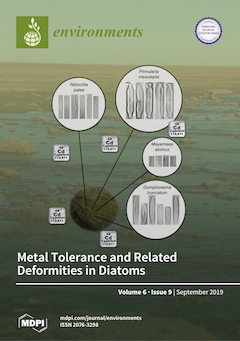The relative tolerance of four diatoms (
Nitzschia palea,
Pinnularia mesolepta,
Mayamaea atomus, and
Gomphonema truncatum) to Cd was evaluated, including their proneness to deformities, and the severity of the abnormalities in relation to Cd concentration. The indirect effect
[...] Read more.
The relative tolerance of four diatoms (
Nitzschia palea,
Pinnularia mesolepta,
Mayamaea atomus, and
Gomphonema truncatum) to Cd was evaluated, including their proneness to deformities, and the severity of the abnormalities in relation to Cd concentration. The indirect effect of Cd on photosynthetic capacities was assessed during a short time exposure experiment using a dose-response approach to evaluate the relative tolerance of the four diatom species. The EC
25 were 9 (3, 23), 606 (348, 926), 1179 (1015, 1349) and 2394 (1890, 2896) µg/L for
P. mesolepta,
G. truncatum,
N. palea, and
M. atomus respectively.
P. mesolepta was by far the most Cd sensitive species while
M. atomus was the most tolerant. In addition, diatoms were exposed to a single concentration of Cd comparable to a heavily contaminated environment for a longer duration to evaluate the effect of Cd on growth kinetics and the deformities induced.
N. palea,
P. mesolepta, and
M. atomus were able to grow when cultivated with Cd while
G. truncatum was not. Cadmium strongly affected the effective quantum yield in
G. truncatum (4.8 ± 5.9% of the control) and
P. mesolepta cultures (29.2 ± 6.9% of the control). The effects were moderate for
N. palea (88.3 ± 0.7% of the control) and no impact was observed for
M. atomus. The results from the two approaches were in accordance since they identified
N. palea and
M. atomus as the two most tolerant species to Cd, while
P. mesolepta and
G. truncatum were the most sensitive. The microscopy analyses revealed that
P. mesolepta was more impacted by Cd than
N. palea and
M. atomus considering both the quantity of abnormal cells and the severity of the deformities. Overall, this research shows that not all deformities can be considered equal for a water quality bio-assessment. The work highlights a need to take into account metal-tolerance/sensitivity of the species and the severity of the deformities.
Full article





